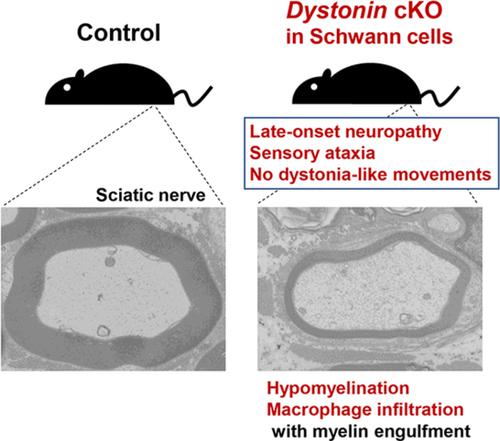Our official English website, www.x-mol.net, welcomes your
feedback! (Note: you will need to create a separate account there.)
Disruption of dystonin in Schwann cells results in late-onset neuropathy and sensory ataxia.
Glia ( IF 5.4 ) Pub Date : 2020-05-23 , DOI: 10.1002/glia.23843 Masao Horie 1, 2, 3 , Nozomu Yoshioka 1 , Satoshi Kusumi 2 , Hiromi Sano 4, 5 , Masayuki Kurose 6, 7 , Izumi Watanabe-Iida 8, 9 , Ibrahim Hossain 1, 10 , Satomi Chiken 4, 5 , Manabu Abe 8, 11 , Kensuke Yamamura 6 , Kenji Sakimura 8, 11 , Atsushi Nambu 4, 5 , Masahiro Shibata 2 , Hirohide Takebayashi 1, 12
Glia ( IF 5.4 ) Pub Date : 2020-05-23 , DOI: 10.1002/glia.23843 Masao Horie 1, 2, 3 , Nozomu Yoshioka 1 , Satoshi Kusumi 2 , Hiromi Sano 4, 5 , Masayuki Kurose 6, 7 , Izumi Watanabe-Iida 8, 9 , Ibrahim Hossain 1, 10 , Satomi Chiken 4, 5 , Manabu Abe 8, 11 , Kensuke Yamamura 6 , Kenji Sakimura 8, 11 , Atsushi Nambu 4, 5 , Masahiro Shibata 2 , Hirohide Takebayashi 1, 12
Affiliation

|
Dystonin (Dst) is a causative gene for Dystonia musculorum (dt) mice, which is an inherited disorder exhibiting dystonia‐like movement and ataxia with sensory degeneration. Dst is expressed in a variety of tissues, including the central nervous system and the peripheral nervous system (PNS), muscles, and skin. However, the Dst‐expressing cell type(s) for dt phenotypes have not been well characterized. To address the questions whether the disruption of Dst in Schwann cells induces movement disorders and how much impact does it have on dt phenotypes, we generated Dst conditional knockout (cKO) mice using P0‐Cre transgenic mice and Dst gene trap mice. First, we assessed the P0‐Cre transgene‐dependent Cre recombination using tdTomato reporter mice and then confirmed the preferential tdTomato expression in Schwann cells. In the Dst cKO mice, Dst mRNA expression was significantly decreased in Schwann cells, but it was intact in most of the sensory neurons in the dorsal root ganglion. Next, we analyzed the phenotype of Dst cKO mice. They exhibited a normal motor phenotype during juvenile periods, and thereafter, started exhibiting an ataxia. Behavioral tests and electrophysiological analyses demonstrated impaired motor abilities and slowed motor nerve conduction velocity in Dst cKO mice, but these mice did not manifest dystonic movements. Electron microscopic observation of the PNS of Dst cKO mice revealed significant numbers of hypomyelinated axons and numerous infiltrating macrophages engulfing myelin debris. These results indicate that Dst is important for normal PNS myelin organization and Dst disruption in Schwann cells induces late‐onset neuropathy and sensory ataxia.
中文翻译:

施万细胞中肌张力蛋白的破坏导致迟发性神经病和感觉性共济失调。
Dystonin(Dst的)为致病基因肌张力障碍(DT)小鼠,这是一种遗传性疾病表现出肌张力障碍样运动和共济失调与感觉变性。Dst在多种组织中表达,包括中枢神经系统和外周神经系统 (PNS)、肌肉和皮肤。然而,dt表型的Dst表达细胞类型尚未得到很好的表征。为了解决雪旺氏细胞中Dst的破坏是否会导致运动障碍以及它对dt表型有多大影响的问题,我们生成了Dst使用P0-Cre转基因小鼠和Dst基因陷阱小鼠的条件敲除 (cKO)小鼠。首先,我们使用tdTomato报告小鼠评估了P0-Cre转基因依赖性 Cre 重组,然后确认了雪旺细胞中的优先 tdTomato 表达。在Dst cKO 小鼠中,施万细胞中Dst mRNA 的表达显着降低,但在背根神经节中的大多数感觉神经元中它是完整的。接下来,我们分析了Dst的表型cKO 小鼠。他们在青少年时期表现出正常的运动表型,此后开始表现出共济失调。行为测试和电生理分析表明Dst cKO 小鼠的运动能力受损,运动神经传导速度减慢,但这些小鼠没有表现出肌张力障碍运动。对Dst cKO 小鼠PNS 的电子显微镜观察揭示了大量髓鞘减少的轴突和大量吞噬髓鞘碎片的浸润巨噬细胞。这些结果表明Dst对正常的 PNS 髓鞘组织很重要,并且Schwann 细胞中的Dst破坏诱导迟发性神经病和感觉性共济失调。
更新日期:2020-05-23
中文翻译:

施万细胞中肌张力蛋白的破坏导致迟发性神经病和感觉性共济失调。
Dystonin(Dst的)为致病基因肌张力障碍(DT)小鼠,这是一种遗传性疾病表现出肌张力障碍样运动和共济失调与感觉变性。Dst在多种组织中表达,包括中枢神经系统和外周神经系统 (PNS)、肌肉和皮肤。然而,dt表型的Dst表达细胞类型尚未得到很好的表征。为了解决雪旺氏细胞中Dst的破坏是否会导致运动障碍以及它对dt表型有多大影响的问题,我们生成了Dst使用P0-Cre转基因小鼠和Dst基因陷阱小鼠的条件敲除 (cKO)小鼠。首先,我们使用tdTomato报告小鼠评估了P0-Cre转基因依赖性 Cre 重组,然后确认了雪旺细胞中的优先 tdTomato 表达。在Dst cKO 小鼠中,施万细胞中Dst mRNA 的表达显着降低,但在背根神经节中的大多数感觉神经元中它是完整的。接下来,我们分析了Dst的表型cKO 小鼠。他们在青少年时期表现出正常的运动表型,此后开始表现出共济失调。行为测试和电生理分析表明Dst cKO 小鼠的运动能力受损,运动神经传导速度减慢,但这些小鼠没有表现出肌张力障碍运动。对Dst cKO 小鼠PNS 的电子显微镜观察揭示了大量髓鞘减少的轴突和大量吞噬髓鞘碎片的浸润巨噬细胞。这些结果表明Dst对正常的 PNS 髓鞘组织很重要,并且Schwann 细胞中的Dst破坏诱导迟发性神经病和感觉性共济失调。











































 京公网安备 11010802027423号
京公网安备 11010802027423号